
Dame Millicent Garrett Fawcett was an English political activist and writer. She campaigned for women's suffrage by legal change and in 1897–1919 led Britain's largest women's rights association, the National Union of Women's Suffrage Societies (NUWSS), explaining, "I cannot say I became a suffragist. I always was one, from the time I was old enough to think at all about the principles of Representative Government." She tried to broaden women's chances of higher education, as a governor of Bedford College, London and co-founding Newnham College, Cambridge in 1875. In 2018, a century after the Representation of the People Act, she was the first woman honoured by a statue in Parliament Square.
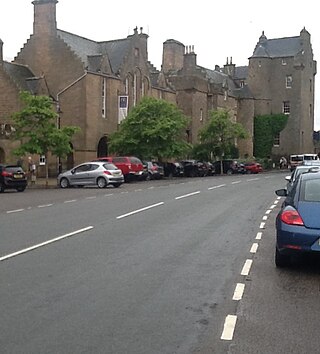
Dornoch is a town, seaside resort, parish and former royal burgh in the county of Sutherland in the Highlands of Scotland. It lies on the north shore of the Dornoch Firth, near to where it opens into the Moray Firth to the east.

Eliza Maud "Elsie" Inglis was a Scottish medical doctor, surgeon, teacher, suffragist, and founder of the Scottish Women's Hospitals. She was the first woman to hold the Serbian Order of the White Eagle.

Helena Maria Lucy Swanwick CH was a British feminist and pacifist. Her autobiography, I Have Been Young (1935), gives a remarkable account of the non-militant women's suffrage campaign in the UK and of anti-war campaigning during the First World War, together with philosophical discussions of non-violence.

A movement to fight for women's right to vote in the United Kingdom finally succeeded through acts of Parliament in 1918 and 1928. It became a national movement in the Victorian era. Women were not explicitly banned from voting in Great Britain until the Reform Act 1832 and the Municipal Corporations Act 1835. In 1872 the fight for women's suffrage became a national movement with the formation of the National Society for Women's Suffrage and later the more influential National Union of Women's Suffrage Societies (NUWSS). As well as in England, women's suffrage movements in Wales, Scotland and other parts of the United Kingdom gained momentum. The movements shifted sentiments in favour of woman suffrage by 1906. It was at this point that the militant campaign began with the formation of the Women's Social and Political Union (WSPU).

Dame Louisa Innes Lumsden was a Scottish pioneer of female education. Lumsden was one of the first five students Hitchen College, later Girton College, Cambridge in 1869 and one of the first three women to pass the Tripos exam in 1873. She returned as the first female resident and tutor to Girton in 1873.

The Open Christmas Letter was a public message for peace addressed "To the Women of Germany and Austria", signed by a group of 101 British suffragists at the end of 1914 as the first Christmas of the First World War approached. The Open Christmas Letter was written in acknowledgment of the mounting horror of modern war and as a direct response to letters written to American feminist Carrie Chapman Catt, the president of the International Woman Suffrage Alliance (IWSA), by a small group of German women's rights activists. Published in January 1915 in Jus Suffragii, the journal of the IWSA, the Open Christmas Letter was answered two months later by a group of 155 prominent German and Austrian women who were pacifists. The exchange of letters between women of nations at war helped promote the aims of peace, and helped prevent the fracturing of the unity which lay in the common goal they shared, suffrage for women.

Helen Miller Fraser, later Moyes, was a Scottish suffragist, feminist, educationalist and Liberal Party politician who later emigrated to Australia.

The Scottish Women's Hospitals for Foreign Services (SWH) was founded in 1914. It was led by Dr Elsie Inglis and provided nurses, doctors, ambulance drivers, cooks and orderlies. By the end of World War I, 14 medical units had been outfitted and sent to serve in Corsica, France, Malta, Romania, Russia, Salonika and Serbia.

The Scottish Women's Hospital at Royaumont was a medical hospital during World War I active from January 1915 to March 1919 operated by Scottish Women's Hospitals (SWH), under the direction of the French Red Cross and located at Royaumont Abbey. The Abbey is a former Cistercian abbey, located near Asnières-sur-Oise in Val-d'Oise, approximately 30 km north of Paris, France. The hospital was started by Dr Frances Ivens and founder of SWH, Dr Elsie Maud Inglis. It was especially noted for its performance treating soldiers involved in the Battle of the Somme.

Lila Clunas was a Scottish suffragette, educator, and Labour Party councillor. She was known as one of the leading suffragettes in Dundee.

Margaret Hills was a British teacher, suffragist organiser, feminist and socialist. She was the first female councillor on Stroud Urban District Council and later served as a Councillor on Gloucestershire County Council.
Caroline Phillips was a Scottish feminist, suffragette and journalist. She was honorary secretary of the Aberdeen branch of the Women's Social and Political Union (WSPU), met and corresponded with many of the leaders of the movement and was also involved in the organisation of militant action in Aberdeen.
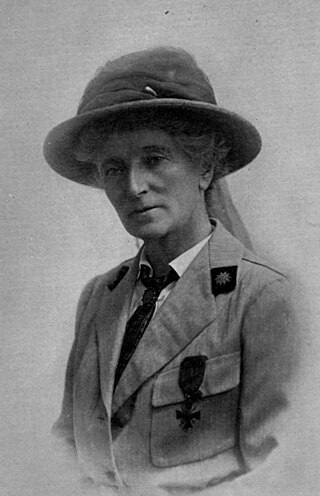
Katherine Mary Harley was a suffragist. In 1913 she proposed and organised the Great Pilgrimage on behalf of the National Union of Women's Suffrage Societies. During the First World War she helped to found and organise the Women's Emergency Corps.
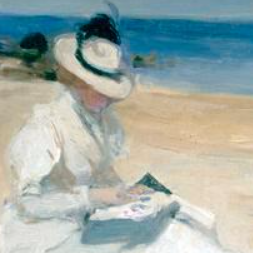
Edith Hacon, also known as Rhyllis Llewellyn Hacon, later Mrs "Amaryllis" Robichaud, was an international socialite, an artists' model and a leading Scottish suffragist. She was vice-president of the Dornoch branch of the National Union of Women's Suffrage Societies and president of the Women's Liberal Association. During the First World War she volunteered with the Scottish Women's Hospitals in France for three years and was awarded a silver Medaille des Epidemics, the British War Medal and Victory Medal. She would later take a key role in the development of Girl Guiding as an early leader in Dornoch in the 1930s.
Elizabeth Courtauld (1867–1947) was a pioneer British physician and anaesthetist, practising in India. She was a volunteer doctor at a field hospital run by women close to the front line in France during the First World War.
Alice Low, (1877–1954) was a British suffragist, who spoke up for peaceful means of achieving women's rights to vote, and fairer laws, including reducing sweated labour. She was a leader in Edinburgh and Berwickshire National Union of Women's Suffrage Societies (NUWSS) and a touring speaker in the early twentieth century. She was also a lead member of Queen Mary's Army Auxiliary Corps. (QMAAC) in World War One and an amateur actress taking lead roles with the British Empire Shakespeare Society.
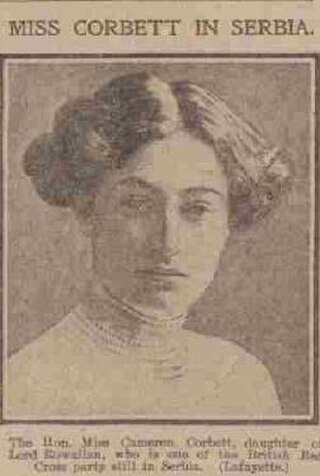
Elsie Cameron Corbett was a volunteer ambulance driver and major donor to the World War One Scottish Women's Hospital for Foreign Service in Serbia, She was a prisoner of war in 1916 and won medals from the Serbian and British governments. She was also a JP, a leading suffragist, temperance supporter, folklorist and diarist.
Helga Gill (1885-1928) was a Norwegian-British suffragette. She was an organiser for the National Union of Women's Suffrage Societies and campaigned on behalf of Women's Suffrage across the UK.
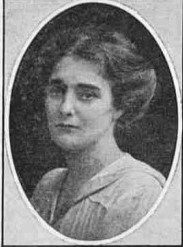
Olive Smith was a masseuse, physical training instructor in the Scottish Women's Hospitals for Foreign Service (SWH) in Serbia in World War I. She died of malaria, within two months of volunteering with Dr Agnes Bennett's SWH unit at Ostrovo, and is buried at the Allies cemetery in Thessaloniki. She is memorialised in her home town Haltwhistle and at the teacher training college she worked at, in Glasgow.

















